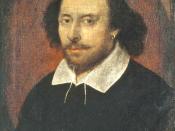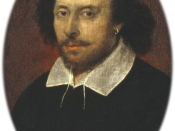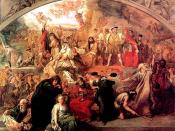In William Shakespeare's poem "That time of year thou may'st in me behold" three metaphors are used to articulate a central theme of transition. The metaphors suggest that the changes such as fall to winter, day to night and fire burning out are complex ways of explaining transitions that occur in love and aging. The sonnet is developing the idea that love exists after passion is gone through the use of common occurrences.
The first metaphor appears in the opening quatrain with a comparison of seasons changing. It is evident that the speaker dialogue is directed to a woman. The next image portrayed is yellow leaves, which provide the reader with a sense of happiness, but the following images of leaves falling off the trees changes those happy thoughts into murky feelings. Immediately the poem changes it's tone creating a sense that the seasons are changing, progressing from fall to winter as our body does with aging.
These progressions are implying that things that once have been luscious and green wither and grow old. The birds no longer perched on the tree boughs chirping their songs because winter is coming. All the transitions that the earth goes through are being compared to aging and growing old. Summer is often compared to youth, energy, and cheerfulness while winter compared to death, idleness, and cold. The opening quatrain leaves the impression that the speaker is preparing of the winter in other words death.
In following quatrain the second metaphor is using the comparison of day to night. The speaker is telling the women that she sees the twilight of the day in him meaning he is old and weary. The sun has set and soon the night will come and when the night comes and twilight appears he grows older and nears...


